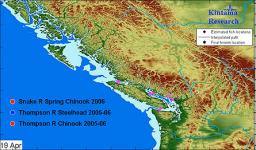forum
library
tutorial
contact

Salmon Study Yields Surprise Result
by Jeff Barnard, Associated PressCapital Press, October 30, 2008
|
the film forum library tutorial contact |

|
Salmon Study Yields Surprise Result
by Jeff Barnard, Associated PressCapital Press, October 30, 2008 |

Juvenile salmon as likely to survive Columbia as undammed river
GRANTS PASS, Ore. - Scientists tracking juvenile salmon migrating downstream to the Pacific were surprised to find just as many or more survived going over eight dams on the Northwest's Snake and Columbia Rivers as survived a major river in British Columbia without any dams at all.
The study, published Monday, Oct. 27, in the online edition of the journal Public Library of Science Biology, comes as salmon advocates, the Bush administration and dam advocates are locked in a federal court battle over whether the Columbia Basin dam system - a major source of power, irrigation and barge transportation - can be made safe enough for salmon to pass muster under the Endangered Species Act.
"We are not saying from our work the dams have no effect on survival," said David Welch, lead author on the study and president of Kintama Research in Nanaimo, B.C., which developed the system used for tracking the fish.
After billions of dollars spent over the past 20 years modifying the dams themselves and changing operations to benefit fish, "It looks like survival levels are now at or above survival levels for the Fraser River, that does not have dams," Welch added. Looking at the years 2004-2006, the study found about 25 percent to 30 percent of juvenile spring chinook survived migrating down both river systems, Welch said. The Fraser's steelhead survival ran about 30 percent and the Columbia's steelhead survival 20 percent to 25 percent. When the greater time or distance for fish migrating down the Columbia was taken into account, survival over the dams was actually higher.
Noting that fewer than 1 percent of salmon survive in some years to spawn as adults, Welch said the biggest threat to salmon is probably in the ocean, where climate and food availability go through wide swings.
Co-author Carl Schreck, a U.S. Geological Survey biologist and professor at Oregon State University, said there was disagreement among Canadian scientists who worked on the study and scientists from Oregon, who felt the results could also have meant that there were major survival problems in the Fraser River that are not known.
Schreck said the study did not take dams off the hook, because salmon may not succumb to the effects until after they have left the river and entered the ocean, where they grow to adults.
The study was based on two sources of data. About 1,000 fish in each river were implanted with an acoustic transmitter about the size of an almond, which sends out a signal tracked by an array of receivers put in the rivers and the ocean. The array, which was developed by Welch's company, is known as POST, for Pacific Ocean Shelf Tracking. Included in the data were results from a long-standing system of monitoring of salmon survival past the Columbia dams using what are known as PIT tags, for Passive Integrated Transponder.
John Ferguson, director of the fish ecology division of the NOAA Fisheries Service science center in Seattle, said the study was instructive, but could not be used to draw broad conclusions about restoring dwindling salmon runs because it only looks at juvenile fish and dams.
Ferguson added that NOAA Fisheries, the federal agency in charge of restoring threatened and endangered salmon, has been talking to Welch about using the POST system to track salmon on California's Sacramento River, where a collapse in returns this year forced the near shutdown of salmon fishing off the West Coast.
Funding came from the Census of Marine Life, the Alfred P. Sloan Foundation, the Gordon and Betty Moore Foundation and the Bonneville Power Administration, which sells the power produced by the Columbia dams.
Related Pages:
Biodiversity: Unraveling the Mysteries of Salmon Migration
by Stephen Leahy, Science Daily, 10/31/8
Do Dams Make A Difference?
IPS News, 10/30/8
Salmon Study Yields Surprise Result
by Jeff Barnard,
Capital Press, 10/30/8
Readers Discuss POST article
by Reader Discussion,
The Oregonian, 10/29/8
Salmon: No Dam Difference?
by Editorial Board,
The Oregonian, 10/29/8
Track the Salmon in California
by Editorial Board,
Contra Costa Times, 10/29/8
New Study Finds Fish Do as Well on Dammed Rivers
by Editorial Board,
Walla Walla Union-Bulletin, 10/29/8
Dams Appear to Have No Impact on Salmon
by Michael Reilly,
Discovery News, 10/29/8
Salmon Smolt Survival Similar in Columbia and Fraser
by Mark Floyd,
Eureka Alert, 10/27/8
Salmon Study Under Fire for Minimizing Effect of Dams
by Warren Cornwall,
Seattle Times, 10/27/8
Research Hints Dam Improvements Helping Salmon
by Michael Milstein,
The Oregonian, 10/27/8
Dams Not Main Cause of Salmon Collapse, Study Says
by James Owen,
National Geographic News, 10/27/8
Study Shows More Salmon Survive West's Dammed Rivers
Canadian Press, 10/27/8
Radio Tags Shed Light on Salmon Migration Routes
by Mark Hume,
Globe and Mail, 10/27/8
learn more on topics covered in the film
see the video
read the script
learn the songs
discussion forum
